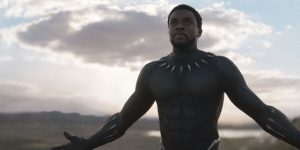
“Black Panther,” the most recent film in the Marvel Cinematic Universe, opened last month with incredible success. Directed by Ryan Coogler and starring Chadwick Boseman as Black Panther, the film broke multiple box office records including highest opening weekend for an African-American director, highest opening weekend for a film in February, and is on track to be the second highest weekend in MCU history, only behind 2012’s “Avengers.” “Black Panther” is also projected to have the highest President’s Day weekend box office ever. Marvel finally has a film that is not led by the same few white people who have dominated the past 17 films; “Black Panther” involves diversity both behind and in front of the camera, resulting in a masterpiece.
The film takes place almost exclusively in Wakanda, a fictional nation located in Eastern Africa, but begins in Oakland, Calif., where a small group of children are playing basketball outside an apartment complex. Meanwhile, King T’Chaka (John Kani) confronts a Wakandan spy who has betrayed their country and sold Vibranium, the natural resource Wakanda evolved from and depends upon. At the close of this sequence, the same children playing basketball see the Wakandan aircraft fly away, unaware of what transpired inside the apartment.
Throughout the film, there are frequent moments of tradition and a dialogue about how technology is ruining those traditions. Once a king dies, as T’Chaka did in “Captain America: Civil War,” his role must be filled. However, in Wakanda, any of the five tribes can challenge the throne. After the Jabari tribe, the tribe separated from the rest of Wakanda, sends a challenger forward who loses, all is well until a new challenger, Killmonger (Michael B. Jordan) defeats newly crowned T’Challa and takes the throne. Killmonger’s rise was aided by Klaw (Andy Serkis), an arms dealer who stole Vibranium to create weapons of incredible power. The finale culminates in a battle including everyone who has been introduced in the film, breaks and creates bonds that will affect the entire MCU, and creates powerful impression for the future of the MCU.
The numerous battle sequences, which grow in length and intensity as the movie comes to a close, do not infringe on the deep character development and attention to detail, both minute and significant. Wakanda is a beautiful, rich, unapologetically black universe; a world woven into a tapestry of sharp colors and textures alongside futuristic buildings and technology, all of which stems from the country’s bounty of Vibranium.
“Black Panther” is almost entirely a standalone film, which is also very unique for the MCU at this point. Since Wakanda has hidden itself from the world, no other Avengers are involved in the entire conflict. At the end of the film, that appears to change. In a press conference, T’Challa discusses the future of Wakanda, leading the press to believe that Wakanda will share its knowledge and technology. Marvel’s “Avengers: Infinity War” will be the moment that many films have been leading to, and what Wakanda’s role will be or how it shares its secrets will be seen on May 4.
The ending of “Black Panther” is rife with deep symbolic meaning, mirroring the first scene in an impactful way. Just as the children look up to see the Wakandan aircraft, they now have numerous black heroes to look up to. T’Challa has become a superhero that the children on screen and in theaters will sit in awe of. Finally, the protagonist in “Black Panther,” as well as innumerable other characters, looks just like them. This movie has been a long time coming, and it was worth the wait.

